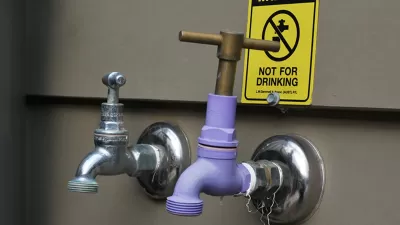On Monday, August 4, half a million people in the Toledo, Ohio metro region could once again drink from their water taps after a weekend without safe drinking water due to a toxin resulting from an algal bloom in the city's water supply, Lake Erie.
Ohio has taken a major step to prevent a recurrence of the drinking water shutdown by requiring farmers to obtain a license to fertilize their fields, report Mark Peters and Matthew Dolan of The Wall Street Journal. Fertilizer runoff is considered one of the major causes of the algal blooms as it contributes a large amount of nitrogen and phosphorus to Lake Erie.
Regulators say the new Ohio licenses, which will become mandatory in 2017 and will require farmers to take a one-day class, are aimed at cutting fertilizer use by showing farmers how they can apply less nutrients without hurting crop yields. The law also allows regulators to revoke such certifications if problems are found on a farm.
The blooms look like thick pea soup as shown in this dramatic photo in National Geographic of a massive algae bloom in 2011. The August 4th article warns that these blooms may become commonplace due in part to climate change.
The licenses will hopefully be just the first of more strategies to come. "Chicago Mayor Rahm Emanuel on Tuesday echoed calls for mayors of Great Lakes cities to hold a summit on water issues in the wake of the recent crisis," add Peters and Dolan. In February "the International Joint Commission, a U.S.-Canadian group monitoring the Great Lakes, called for cutting the daily amount of phosphorus flowing into Lake Erie by nearly half by 2022 in a bid to protect drinking water as well as fish," they write.
The report urged other states, including Michigan, New York, Ohio, Pennsylvania and Indiana, as well as parts of Canada, to stop farmers from applying fertilizers on snow-covered or frozen ground to help reduce nutrient levels in waterways
Adam Sharp, vice president of public policy for the Ohio Farm Bureau Federation, praised the new license requirement. "The law has 'teeth' because it will go after bad actors who recklessly apply fertilizer," notes the Bureau's public statement on the water crisis.
However, some feel that the license, plus additional recent measures the state has taken to reduce water pollution, don't go far enough.
"This isn't a matter of farmers fine-tuning what they're doing," said Howard Learner, president of the Environmental Law and Policy Center, a Midwest advocacy group. "This requires a substantial rethinking of how nitrogen and phosphorus is used in the agriculture sector," he added.
Correspondent's note: Subscriber-only content to The Wall Street Journal article will be available to non-subscribers for up to seven days after August 6th.
FULL STORY: Ohio Regulators Aim to Help Water Problem With Fertilizer Licenses

Alabama: Trump Terminates Settlements for Black Communities Harmed By Raw Sewage
Trump deemed the landmark civil rights agreement “illegal DEI and environmental justice policy.”

Study: Maui’s Plan to Convert Vacation Rentals to Long-Term Housing Could Cause Nearly $1 Billion Economic Loss
The plan would reduce visitor accommodation by 25% resulting in 1,900 jobs lost.

Why Should We Subsidize Public Transportation?
Many public transit agencies face financial stress due to rising costs, declining fare revenue, and declining subsidies. Transit advocates must provide a strong business case for increasing public transit funding.

Paris Bike Boom Leads to Steep Drop in Air Pollution
The French city’s air quality has improved dramatically in the past 20 years, coinciding with a growth in cycling.

Why Housing Costs More to Build in California Than in Texas
Hard costs like labor and materials combined with ‘soft’ costs such as permitting make building in the San Francisco Bay Area almost three times as costly as in Texas cities.

San Diego County Sees a Rise in Urban Coyotes
San Diego County experiences a rise in urban coyotes, as sightings become prevalent throughout its urban neighbourhoods and surrounding areas.
Urban Design for Planners 1: Software Tools
This six-course series explores essential urban design concepts using open source software and equips planners with the tools they need to participate fully in the urban design process.
Planning for Universal Design
Learn the tools for implementing Universal Design in planning regulations.
Smith Gee Studio
Alamo Area Metropolitan Planning Organization
City of Santa Clarita
Institute for Housing and Urban Development Studies (IHS)
City of Grandview
Harvard GSD Executive Education
Toledo-Lucas County Plan Commissions
Salt Lake City
NYU Wagner Graduate School of Public Service




























